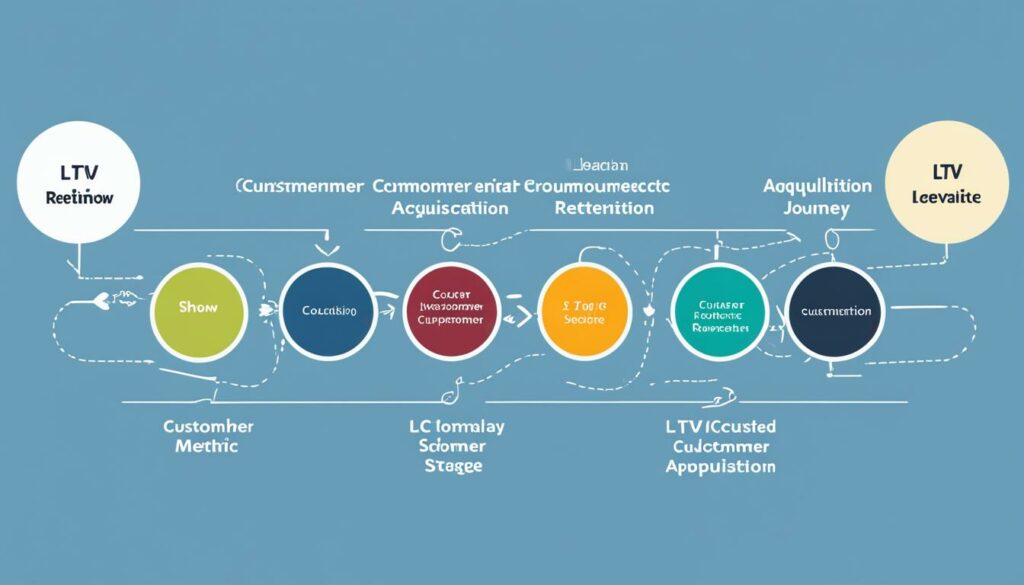In the world of ecommerce, customer lifetime value (LTV) is a crucial metric that measures the total expected revenue from a single customer over the course of their relationship with your brand. It is essential for driving long-term growth and success in the competitive ecommerce landscape. Understanding LTV allows ecommerce businesses to make informed decisions about acquisition, retention, and marketing strategies. It provides insights into customer value, guides resource allocation, and helps with long-term business planning.
Key Takeaways:
- LTV is a metric that measures the total expected revenue from a single customer over their relationship with your brand.
- Understanding LTV helps ecommerce businesses make informed decisions about acquisition, retention, and marketing strategies.
- LTV encompasses purchase frequency, average order value, and customer lifespan as its key components.
- Calculating LTV involves multiplying the average order value, purchase frequency, and customer lifespan.
- LTV is important for budgeting, customer acquisition strategies, and improving overall profitability.
What is LTV in Ecommerce?
In the context of ecommerce, customer lifetime value (LTV) is a metric that estimates the total revenue a business can expect from a single customer over the lifetime of their relationship. It takes into consideration factors such as purchase history, purchase frequency, and relationship duration.
LTV is important because it provides a clear view of the ongoing worth of each customer, allowing businesses to make informed decisions about acquisition, retention, and marketing strategies. By understanding the lifetime value of a customer, businesses can prioritize their efforts in acquiring high-value customers, retaining them for longer periods, and maximizing their profitability.
“LTV is like a compass that guides businesses in the right direction for sustainable growth and long-term success.”
By analyzing LTV, ecommerce businesses can identify which customer segments or individual customers are generating the most value. This information can then be used to optimize marketing campaigns, tailor promotions, and provide personalized experiences. Additionally, LTV helps businesses allocate resources effectively by focusing on the activities that drive the highest returns.
Moreover, LTV serves as a key performance indicator (KPI) for evaluating the success of various business initiatives. It can be used to measure the effectiveness of retention strategies, customer loyalty programs, and customer relationship management efforts.
Ultimately, understanding the LTV of customers enables businesses to strategically invest in activities that lead to sustainable growth and increased profitability. By continuously monitoring and improving LTV metrics, ecommerce brands can unlock the full potential of their customer base and build a solid foundation for long-term success.
The Lifetime Value Formula
The formula for calculating LTV is:
LTV = average order value x average purchase frequency x customer lifespan
By plugging in the appropriate values for these components, businesses can determine the expected lifetime value of a customer and make data-driven decisions to optimize their LTV.

In the next section, we will explore the key components that contribute to LTV in ecommerce and how they impact the overall value of a customer.
The Key Components of LTV
LTV in ecommerce encompasses three key components: purchase frequency, average order value, and customer lifespan.
Purchase frequency refers to how often a customer makes purchases within a given period. It is a measure of customer loyalty and indicates consistent revenue. By analyzing purchase frequency, businesses can identify their most loyal customers and develop strategies to encourage repeat purchases.
Average order value represents the average amount of money a customer spends per transaction. This metric provides insights into the revenue generated per customer and helps businesses understand their customers’ spending habits. Increasing the average order value can significantly impact the overall profitability of an ecommerce business.
Customer lifespan refers to the average length of time a customer maintains a relationship with the business. This component directly impacts the overall revenue generated. By extending the customer lifespan, businesses can maximize the value they extract from each customer and build long-lasting relationships that result in sustained revenue.
List of LTV Components:
- Purchase frequency
- Average order value
- Customer lifespan
Understanding and optimizing these LTV components is essential for ecommerce businesses seeking to improve customer acquisition, retention, and overall profitability. By focusing on these key factors, businesses can develop targeted strategies to maximize the lifetime value of their customers.

Example Quote:
“By analyzing purchase frequency, average order value, and customer lifespan, businesses can unlock valuable insights into customer behavior and make data-driven decisions to optimize their LTV.” – Ecommerce Expert
How to Calculate LTV in Ecommerce
Calculating the Lifetime Value (LTV) of customers in ecommerce is a vital step in understanding their overall worth to your business. By determining the expected revenue generated from each customer over their lifetime, you can make informed decisions about allocation of resources, budgeting, and customer acquisition strategies.
The formula for calculating LTV in ecommerce is relatively straightforward:
LTV = average order value x average purchase frequency x customer lifespan
Let’s break down the components of this formula:
| Component | Description |
|---|---|
| Average order value | The average amount of money a customer spends per transaction. This helps determine revenue generated per customer. |
| Average purchase frequency | The average number of purchases a customer makes within a given period. It reflects customer loyalty and consistent revenue. |
| Customer lifespan | The average length of time a customer maintains a relationship with your business. It impacts the overall revenue generated. |
To calculate LTV, plug in the appropriate values for these components based on your business data. The result will give you an estimation of the expected lifetime value of each customer.
Here’s an example:
Let’s say your average order value is $50, the average purchase frequency is 2 purchases per month, and the average customer lifespan is 5 years. Plug these values into the formula:
LTV = $50 x 2 x 5 = $500
In this scenario, the estimated LTV for each customer is $500.
Calculating LTV is crucial for a variety of reasons. It helps you in making informed decisions about budgeting, determining marketing strategies, and improving overall profitability. By understanding the lifetime value of customers, you can focus on maximizing customer retention and optimizing your business strategies for long-term success.

The Importance of LTV in Ecommerce
Understanding the significance of Lifetime Value (LTV) is essential for any ecommerce business. LTV provides valuable insights into the true worth of each customer, enabling strategic decision-making and effective resource allocation. By analyzing LTV, businesses can optimize their marketing efforts, improve customer retention, and maximize profitability.
One of the key benefits of LTV is its ability to guide long-term business planning. By accurately estimating the ongoing value of customers, ecommerce businesses can develop sustainable growth strategies and create a roadmap for success. LTV also helps in striking the perfect balance between advertising costs and expected revenue from customers, ensuring the overall sustainability of the business.
In the highly competitive ecommerce landscape, LTV plays a crucial role in distinguishing successful businesses from those that struggle to thrive. By harnessing the insights provided by LTV, businesses can make informed decisions about customer acquisition, retention strategies, and marketing campaigns. This not only improves customer satisfaction but also drives long-term growth and success.
FAQ
What is Lifetime Value (LTV) of a Customer in Ecommerce?
Lifetime Value (LTV) of a customer in ecommerce refers to the total expected revenue from a single customer over the course of their relationship with your brand. It is a crucial metric for driving long-term growth and success in the competitive ecommerce landscape.
What is LTV in ecommerce?
LTV in ecommerce is a metric that estimates the total revenue a business can expect from a single customer over the lifetime of their relationship. It takes into consideration factors such as purchase history, purchase frequency, and relationship duration. LTV is important because it provides a clear view of the ongoing worth of each customer, allowing businesses to make informed decisions about acquisition, retention, and marketing strategies.
What are the key components of LTV?
The key components of LTV in ecommerce are purchase frequency, average order value, and customer lifespan. Purchase frequency measures how often a customer makes purchases within a given period and indicates customer loyalty and consistent revenue. Average order value represents the average amount of money a customer spends per transaction and indicates the revenue generated per customer. Customer lifespan refers to the average length of time a customer maintains a relationship with the business and impacts the overall revenue generated.
How can I calculate LTV in Ecommerce?
Calculating LTV in ecommerce is relatively straightforward. The formula for calculating LTV is: LTV = average order value x average purchase frequency x customer lifespan. By plugging in the appropriate values for these components, businesses can determine the expected lifetime value of a customer. This calculation is crucial for budgeting purposes, customer acquisition strategies, and improving overall profitability.
Why is LTV important in Ecommerce?
LTV is an essential metric in ecommerce because it provides valuable insights into customer value, helps with strategic decision-making, guides resource allocation, and facilitates long-term business planning. By understanding the ongoing worth of each customer, businesses can optimize their marketing efforts, improve customer retention, and maximize profitability. LTV also helps businesses strike a balance between advertising costs and expected revenue from customers, ensuring the sustainability and growth of the ecommerce business.
